Analysis of Overweight and Obesity Prevention Policy in Australia
VerifiedAdded on 2023/01/20
|14
|4023
|1
Report
AI Summary
This report analyzes the overweight and obesity prevention policies in Australia, examining the alarming rise in obesity rates and the associated health and economic burdens. It delves into various guidelines, including the Australian Dietary Guidelines, Health Star Rating, and physical activity guidelines, while also highlighting the absence of a specific national obesity policy. The report explores the objectives and goals of an effective policy, emphasizing the need for promoting healthy lifestyles, restricting unhealthy food promotions, and implementing a comprehensive approach involving resource allocation, financial requirements, and timelines. It further discusses the decision-making parameters and potential obstacles in policy implementation, such as political influences and resistance from vested interests. The analysis underscores the importance of a multi-faceted strategy to tackle the obesity epidemic, incorporating public health initiatives, regulatory reforms, and collaborative efforts to promote healthy eating habits and physical activity across all age groups.
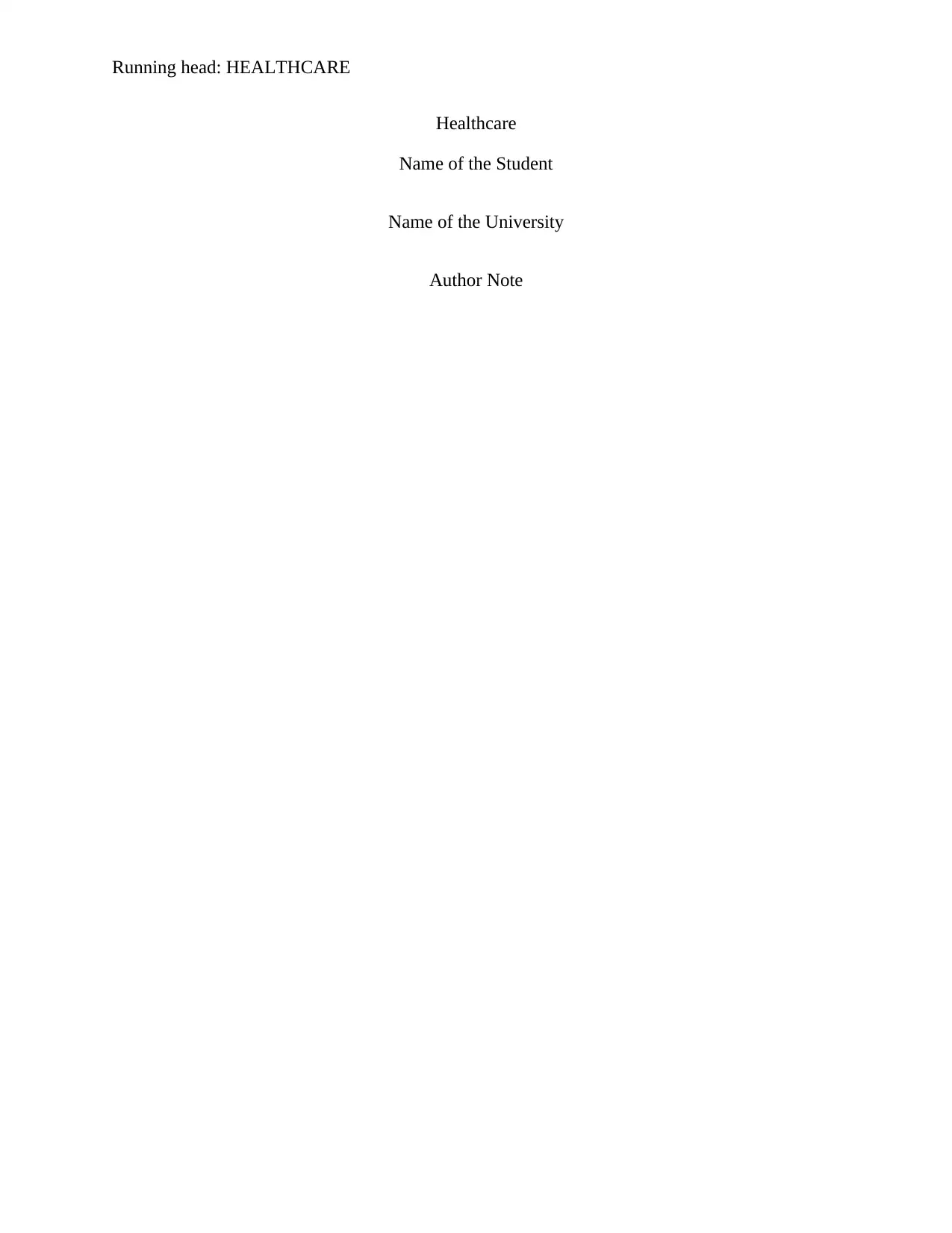
Running head: HEALTHCARE
Healthcare
Name of the Student
Name of the University
Author Note
Healthcare
Name of the Student
Name of the University
Author Note
Paraphrase This Document
Need a fresh take? Get an instant paraphrase of this document with our AI Paraphraser
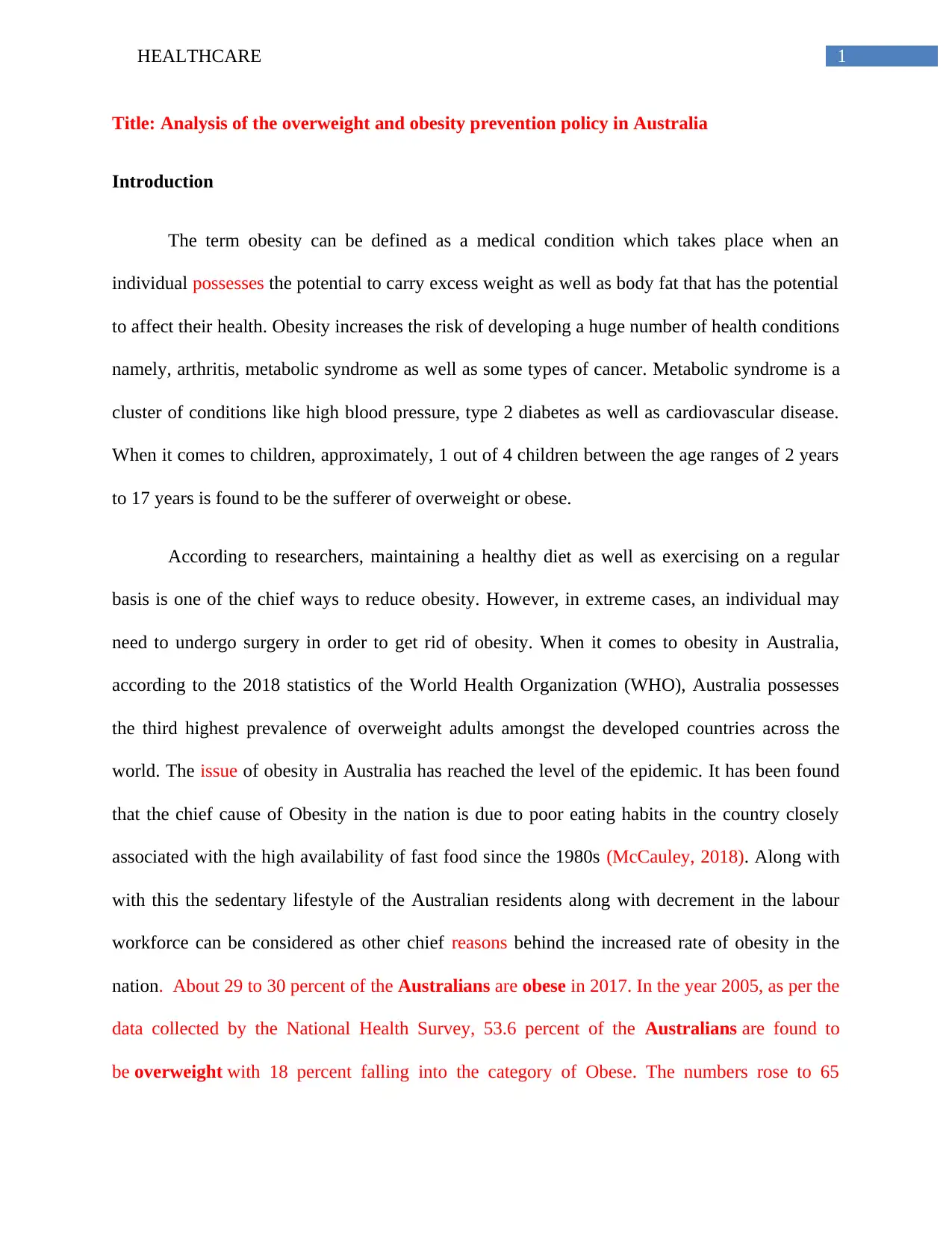
1HEALTHCARE
Title: Analysis of the overweight and obesity prevention policy in Australia
Introduction
The term obesity can be defined as a medical condition which takes place when an
individual possesses the potential to carry excess weight as well as body fat that has the potential
to affect their health. Obesity increases the risk of developing a huge number of health conditions
namely, arthritis, metabolic syndrome as well as some types of cancer. Metabolic syndrome is a
cluster of conditions like high blood pressure, type 2 diabetes as well as cardiovascular disease.
When it comes to children, approximately, 1 out of 4 children between the age ranges of 2 years
to 17 years is found to be the sufferer of overweight or obese.
According to researchers, maintaining a healthy diet as well as exercising on a regular
basis is one of the chief ways to reduce obesity. However, in extreme cases, an individual may
need to undergo surgery in order to get rid of obesity. When it comes to obesity in Australia,
according to the 2018 statistics of the World Health Organization (WHO), Australia possesses
the third highest prevalence of overweight adults amongst the developed countries across the
world. The issue of obesity in Australia has reached the level of the epidemic. It has been found
that the chief cause of Obesity in the nation is due to poor eating habits in the country closely
associated with the high availability of fast food since the 1980s (McCauley, 2018). Along with
with this the sedentary lifestyle of the Australian residents along with decrement in the labour
workforce can be considered as other chief reasons behind the increased rate of obesity in the
nation. About 29 to 30 percent of the Australians are obese in 2017. In the year 2005, as per the
data collected by the National Health Survey, 53.6 percent of the Australians are found to
be overweight with 18 percent falling into the category of Obese. The numbers rose to 65
Title: Analysis of the overweight and obesity prevention policy in Australia
Introduction
The term obesity can be defined as a medical condition which takes place when an
individual possesses the potential to carry excess weight as well as body fat that has the potential
to affect their health. Obesity increases the risk of developing a huge number of health conditions
namely, arthritis, metabolic syndrome as well as some types of cancer. Metabolic syndrome is a
cluster of conditions like high blood pressure, type 2 diabetes as well as cardiovascular disease.
When it comes to children, approximately, 1 out of 4 children between the age ranges of 2 years
to 17 years is found to be the sufferer of overweight or obese.
According to researchers, maintaining a healthy diet as well as exercising on a regular
basis is one of the chief ways to reduce obesity. However, in extreme cases, an individual may
need to undergo surgery in order to get rid of obesity. When it comes to obesity in Australia,
according to the 2018 statistics of the World Health Organization (WHO), Australia possesses
the third highest prevalence of overweight adults amongst the developed countries across the
world. The issue of obesity in Australia has reached the level of the epidemic. It has been found
that the chief cause of Obesity in the nation is due to poor eating habits in the country closely
associated with the high availability of fast food since the 1980s (McCauley, 2018). Along with
with this the sedentary lifestyle of the Australian residents along with decrement in the labour
workforce can be considered as other chief reasons behind the increased rate of obesity in the
nation. About 29 to 30 percent of the Australians are obese in 2017. In the year 2005, as per the
data collected by the National Health Survey, 53.6 percent of the Australians are found to
be overweight with 18 percent falling into the category of Obese. The numbers rose to 65
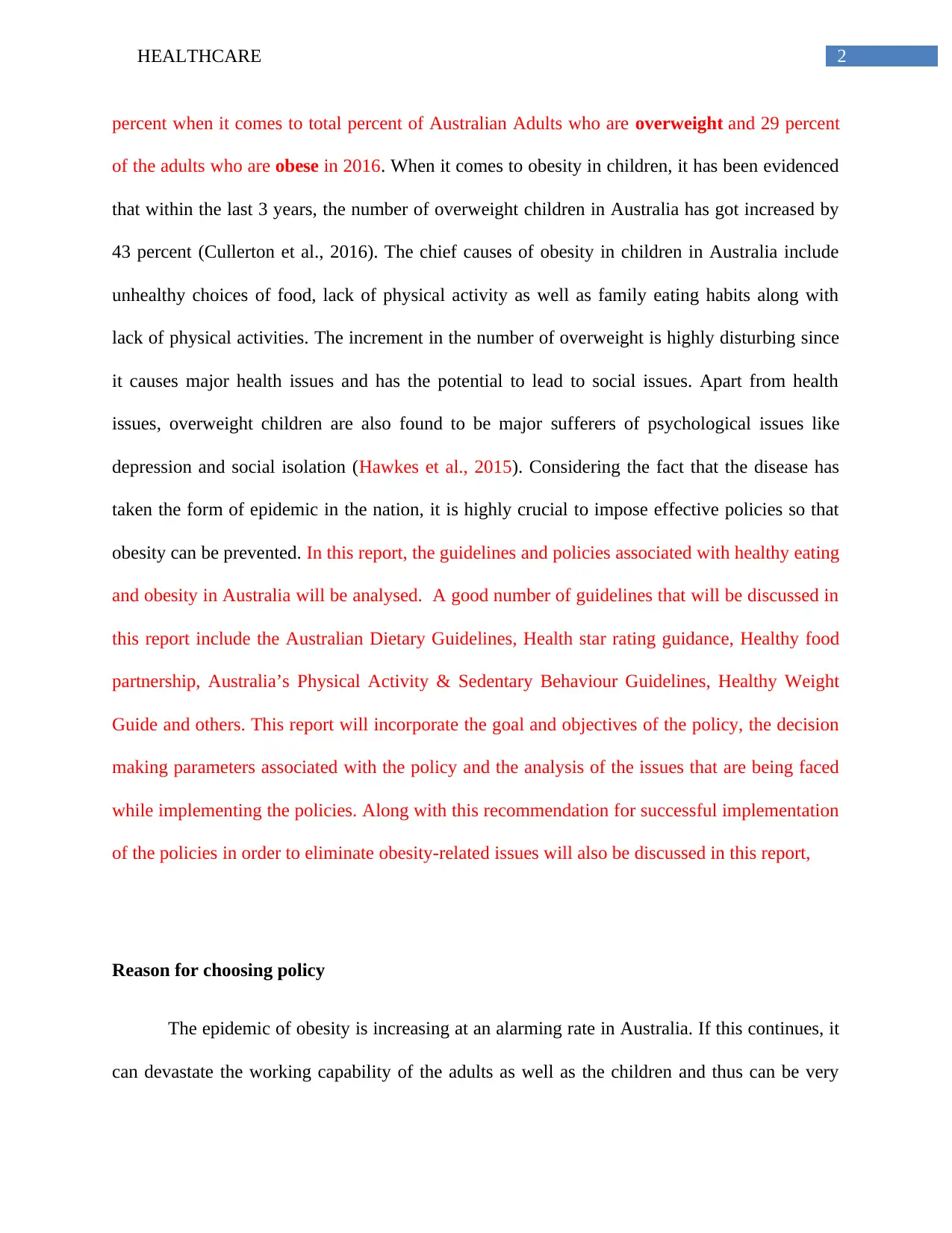
2HEALTHCARE
percent when it comes to total percent of Australian Adults who are overweight and 29 percent
of the adults who are obese in 2016. When it comes to obesity in children, it has been evidenced
that within the last 3 years, the number of overweight children in Australia has got increased by
43 percent (Cullerton et al., 2016). The chief causes of obesity in children in Australia include
unhealthy choices of food, lack of physical activity as well as family eating habits along with
lack of physical activities. The increment in the number of overweight is highly disturbing since
it causes major health issues and has the potential to lead to social issues. Apart from health
issues, overweight children are also found to be major sufferers of psychological issues like
depression and social isolation (Hawkes et al., 2015). Considering the fact that the disease has
taken the form of epidemic in the nation, it is highly crucial to impose effective policies so that
obesity can be prevented. In this report, the guidelines and policies associated with healthy eating
and obesity in Australia will be analysed. A good number of guidelines that will be discussed in
this report include the Australian Dietary Guidelines, Health star rating guidance, Healthy food
partnership, Australia’s Physical Activity & Sedentary Behaviour Guidelines, Healthy Weight
Guide and others. This report will incorporate the goal and objectives of the policy, the decision
making parameters associated with the policy and the analysis of the issues that are being faced
while implementing the policies. Along with this recommendation for successful implementation
of the policies in order to eliminate obesity-related issues will also be discussed in this report,
Reason for choosing policy
The epidemic of obesity is increasing at an alarming rate in Australia. If this continues, it
can devastate the working capability of the adults as well as the children and thus can be very
percent when it comes to total percent of Australian Adults who are overweight and 29 percent
of the adults who are obese in 2016. When it comes to obesity in children, it has been evidenced
that within the last 3 years, the number of overweight children in Australia has got increased by
43 percent (Cullerton et al., 2016). The chief causes of obesity in children in Australia include
unhealthy choices of food, lack of physical activity as well as family eating habits along with
lack of physical activities. The increment in the number of overweight is highly disturbing since
it causes major health issues and has the potential to lead to social issues. Apart from health
issues, overweight children are also found to be major sufferers of psychological issues like
depression and social isolation (Hawkes et al., 2015). Considering the fact that the disease has
taken the form of epidemic in the nation, it is highly crucial to impose effective policies so that
obesity can be prevented. In this report, the guidelines and policies associated with healthy eating
and obesity in Australia will be analysed. A good number of guidelines that will be discussed in
this report include the Australian Dietary Guidelines, Health star rating guidance, Healthy food
partnership, Australia’s Physical Activity & Sedentary Behaviour Guidelines, Healthy Weight
Guide and others. This report will incorporate the goal and objectives of the policy, the decision
making parameters associated with the policy and the analysis of the issues that are being faced
while implementing the policies. Along with this recommendation for successful implementation
of the policies in order to eliminate obesity-related issues will also be discussed in this report,
Reason for choosing policy
The epidemic of obesity is increasing at an alarming rate in Australia. If this continues, it
can devastate the working capability of the adults as well as the children and thus can be very
⊘ This is a preview!⊘
Do you want full access?
Subscribe today to unlock all pages.

Trusted by 1+ million students worldwide
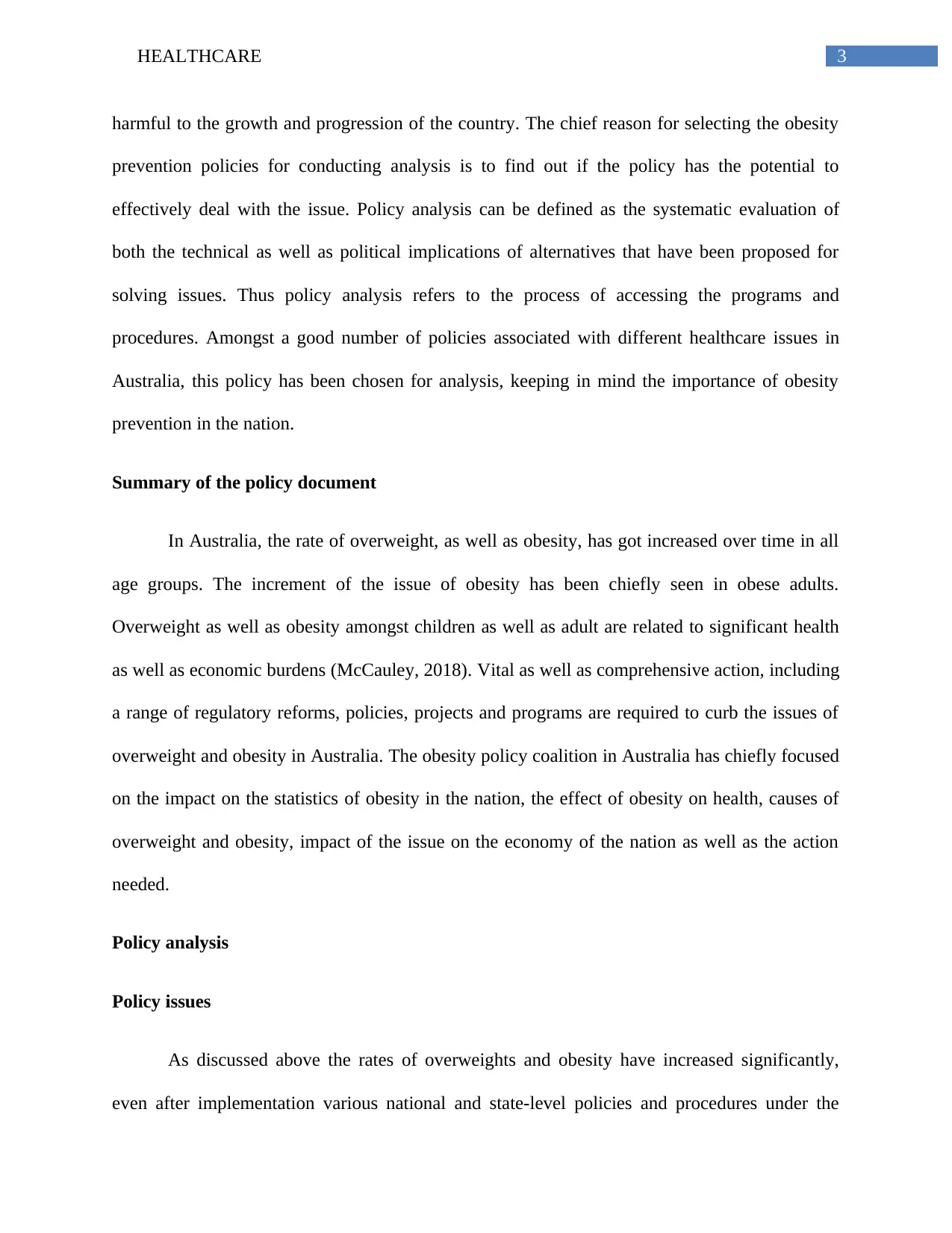
3HEALTHCARE
harmful to the growth and progression of the country. The chief reason for selecting the obesity
prevention policies for conducting analysis is to find out if the policy has the potential to
effectively deal with the issue. Policy analysis can be defined as the systematic evaluation of
both the technical as well as political implications of alternatives that have been proposed for
solving issues. Thus policy analysis refers to the process of accessing the programs and
procedures. Amongst a good number of policies associated with different healthcare issues in
Australia, this policy has been chosen for analysis, keeping in mind the importance of obesity
prevention in the nation.
Summary of the policy document
In Australia, the rate of overweight, as well as obesity, has got increased over time in all
age groups. The increment of the issue of obesity has been chiefly seen in obese adults.
Overweight as well as obesity amongst children as well as adult are related to significant health
as well as economic burdens (McCauley, 2018). Vital as well as comprehensive action, including
a range of regulatory reforms, policies, projects and programs are required to curb the issues of
overweight and obesity in Australia. The obesity policy coalition in Australia has chiefly focused
on the impact on the statistics of obesity in the nation, the effect of obesity on health, causes of
overweight and obesity, impact of the issue on the economy of the nation as well as the action
needed.
Policy analysis
Policy issues
As discussed above the rates of overweights and obesity have increased significantly,
even after implementation various national and state-level policies and procedures under the
harmful to the growth and progression of the country. The chief reason for selecting the obesity
prevention policies for conducting analysis is to find out if the policy has the potential to
effectively deal with the issue. Policy analysis can be defined as the systematic evaluation of
both the technical as well as political implications of alternatives that have been proposed for
solving issues. Thus policy analysis refers to the process of accessing the programs and
procedures. Amongst a good number of policies associated with different healthcare issues in
Australia, this policy has been chosen for analysis, keeping in mind the importance of obesity
prevention in the nation.
Summary of the policy document
In Australia, the rate of overweight, as well as obesity, has got increased over time in all
age groups. The increment of the issue of obesity has been chiefly seen in obese adults.
Overweight as well as obesity amongst children as well as adult are related to significant health
as well as economic burdens (McCauley, 2018). Vital as well as comprehensive action, including
a range of regulatory reforms, policies, projects and programs are required to curb the issues of
overweight and obesity in Australia. The obesity policy coalition in Australia has chiefly focused
on the impact on the statistics of obesity in the nation, the effect of obesity on health, causes of
overweight and obesity, impact of the issue on the economy of the nation as well as the action
needed.
Policy analysis
Policy issues
As discussed above the rates of overweights and obesity have increased significantly,
even after implementation various national and state-level policies and procedures under the
Paraphrase This Document
Need a fresh take? Get an instant paraphrase of this document with our AI Paraphraser
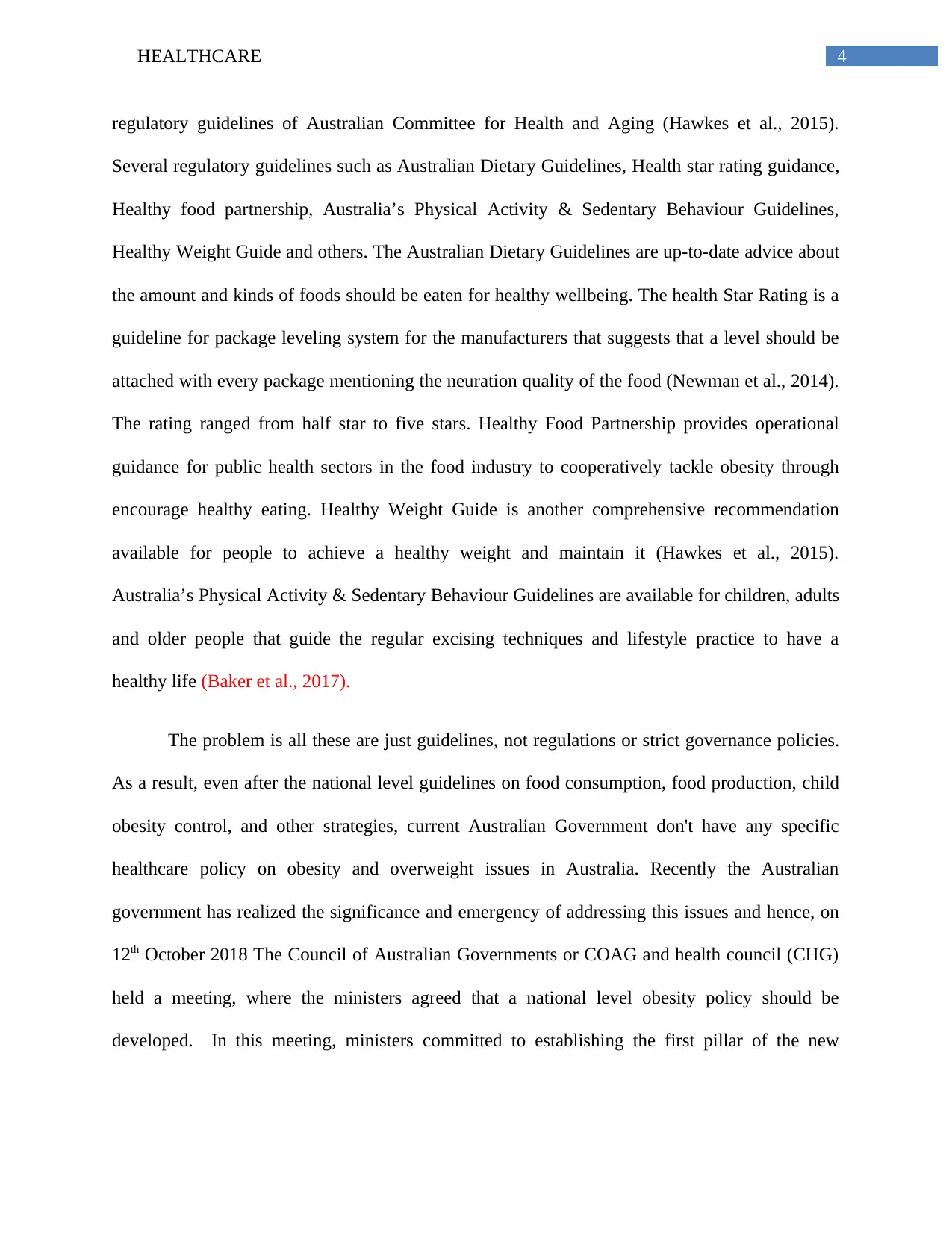
4HEALTHCARE
regulatory guidelines of Australian Committee for Health and Aging (Hawkes et al., 2015).
Several regulatory guidelines such as Australian Dietary Guidelines, Health star rating guidance,
Healthy food partnership, Australia’s Physical Activity & Sedentary Behaviour Guidelines,
Healthy Weight Guide and others. The Australian Dietary Guidelines are up-to-date advice about
the amount and kinds of foods should be eaten for healthy wellbeing. The health Star Rating is a
guideline for package leveling system for the manufacturers that suggests that a level should be
attached with every package mentioning the neuration quality of the food (Newman et al., 2014).
The rating ranged from half star to five stars. Healthy Food Partnership provides operational
guidance for public health sectors in the food industry to cooperatively tackle obesity through
encourage healthy eating. Healthy Weight Guide is another comprehensive recommendation
available for people to achieve a healthy weight and maintain it (Hawkes et al., 2015).
Australia’s Physical Activity & Sedentary Behaviour Guidelines are available for children, adults
and older people that guide the regular excising techniques and lifestyle practice to have a
healthy life (Baker et al., 2017).
The problem is all these are just guidelines, not regulations or strict governance policies.
As a result, even after the national level guidelines on food consumption, food production, child
obesity control, and other strategies, current Australian Government don't have any specific
healthcare policy on obesity and overweight issues in Australia. Recently the Australian
government has realized the significance and emergency of addressing this issues and hence, on
12th October 2018 The Council of Australian Governments or COAG and health council (CHG)
held a meeting, where the ministers agreed that a national level obesity policy should be
developed. In this meeting, ministers committed to establishing the first pillar of the new
regulatory guidelines of Australian Committee for Health and Aging (Hawkes et al., 2015).
Several regulatory guidelines such as Australian Dietary Guidelines, Health star rating guidance,
Healthy food partnership, Australia’s Physical Activity & Sedentary Behaviour Guidelines,
Healthy Weight Guide and others. The Australian Dietary Guidelines are up-to-date advice about
the amount and kinds of foods should be eaten for healthy wellbeing. The health Star Rating is a
guideline for package leveling system for the manufacturers that suggests that a level should be
attached with every package mentioning the neuration quality of the food (Newman et al., 2014).
The rating ranged from half star to five stars. Healthy Food Partnership provides operational
guidance for public health sectors in the food industry to cooperatively tackle obesity through
encourage healthy eating. Healthy Weight Guide is another comprehensive recommendation
available for people to achieve a healthy weight and maintain it (Hawkes et al., 2015).
Australia’s Physical Activity & Sedentary Behaviour Guidelines are available for children, adults
and older people that guide the regular excising techniques and lifestyle practice to have a
healthy life (Baker et al., 2017).
The problem is all these are just guidelines, not regulations or strict governance policies.
As a result, even after the national level guidelines on food consumption, food production, child
obesity control, and other strategies, current Australian Government don't have any specific
healthcare policy on obesity and overweight issues in Australia. Recently the Australian
government has realized the significance and emergency of addressing this issues and hence, on
12th October 2018 The Council of Australian Governments or COAG and health council (CHG)
held a meeting, where the ministers agreed that a national level obesity policy should be
developed. In this meeting, ministers committed to establishing the first pillar of the new
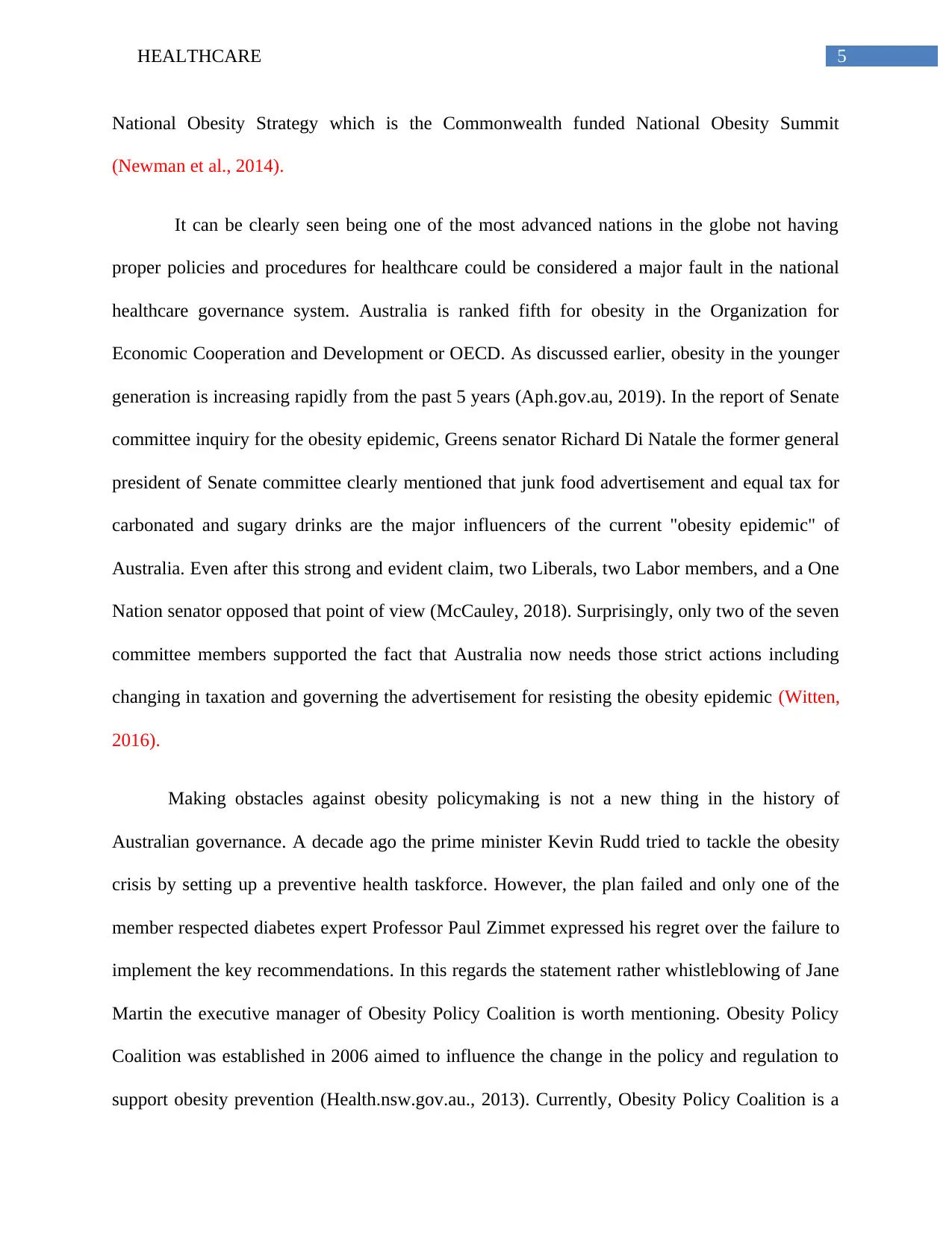
5HEALTHCARE
National Obesity Strategy which is the Commonwealth funded National Obesity Summit
(Newman et al., 2014).
It can be clearly seen being one of the most advanced nations in the globe not having
proper policies and procedures for healthcare could be considered a major fault in the national
healthcare governance system. Australia is ranked fifth for obesity in the Organization for
Economic Cooperation and Development or OECD. As discussed earlier, obesity in the younger
generation is increasing rapidly from the past 5 years (Aph.gov.au, 2019). In the report of Senate
committee inquiry for the obesity epidemic, Greens senator Richard Di Natale the former general
president of Senate committee clearly mentioned that junk food advertisement and equal tax for
carbonated and sugary drinks are the major influencers of the current "obesity epidemic" of
Australia. Even after this strong and evident claim, two Liberals, two Labor members, and a One
Nation senator opposed that point of view (McCauley, 2018). Surprisingly, only two of the seven
committee members supported the fact that Australia now needs those strict actions including
changing in taxation and governing the advertisement for resisting the obesity epidemic (Witten,
2016).
Making obstacles against obesity policymaking is not a new thing in the history of
Australian governance. A decade ago the prime minister Kevin Rudd tried to tackle the obesity
crisis by setting up a preventive health taskforce. However, the plan failed and only one of the
member respected diabetes expert Professor Paul Zimmet expressed his regret over the failure to
implement the key recommendations. In this regards the statement rather whistleblowing of Jane
Martin the executive manager of Obesity Policy Coalition is worth mentioning. Obesity Policy
Coalition was established in 2006 aimed to influence the change in the policy and regulation to
support obesity prevention (Health.nsw.gov.au., 2013). Currently, Obesity Policy Coalition is a
National Obesity Strategy which is the Commonwealth funded National Obesity Summit
(Newman et al., 2014).
It can be clearly seen being one of the most advanced nations in the globe not having
proper policies and procedures for healthcare could be considered a major fault in the national
healthcare governance system. Australia is ranked fifth for obesity in the Organization for
Economic Cooperation and Development or OECD. As discussed earlier, obesity in the younger
generation is increasing rapidly from the past 5 years (Aph.gov.au, 2019). In the report of Senate
committee inquiry for the obesity epidemic, Greens senator Richard Di Natale the former general
president of Senate committee clearly mentioned that junk food advertisement and equal tax for
carbonated and sugary drinks are the major influencers of the current "obesity epidemic" of
Australia. Even after this strong and evident claim, two Liberals, two Labor members, and a One
Nation senator opposed that point of view (McCauley, 2018). Surprisingly, only two of the seven
committee members supported the fact that Australia now needs those strict actions including
changing in taxation and governing the advertisement for resisting the obesity epidemic (Witten,
2016).
Making obstacles against obesity policymaking is not a new thing in the history of
Australian governance. A decade ago the prime minister Kevin Rudd tried to tackle the obesity
crisis by setting up a preventive health taskforce. However, the plan failed and only one of the
member respected diabetes expert Professor Paul Zimmet expressed his regret over the failure to
implement the key recommendations. In this regards the statement rather whistleblowing of Jane
Martin the executive manager of Obesity Policy Coalition is worth mentioning. Obesity Policy
Coalition was established in 2006 aimed to influence the change in the policy and regulation to
support obesity prevention (Health.nsw.gov.au., 2013). Currently, Obesity Policy Coalition is a
⊘ This is a preview!⊘
Do you want full access?
Subscribe today to unlock all pages.

Trusted by 1+ million students worldwide
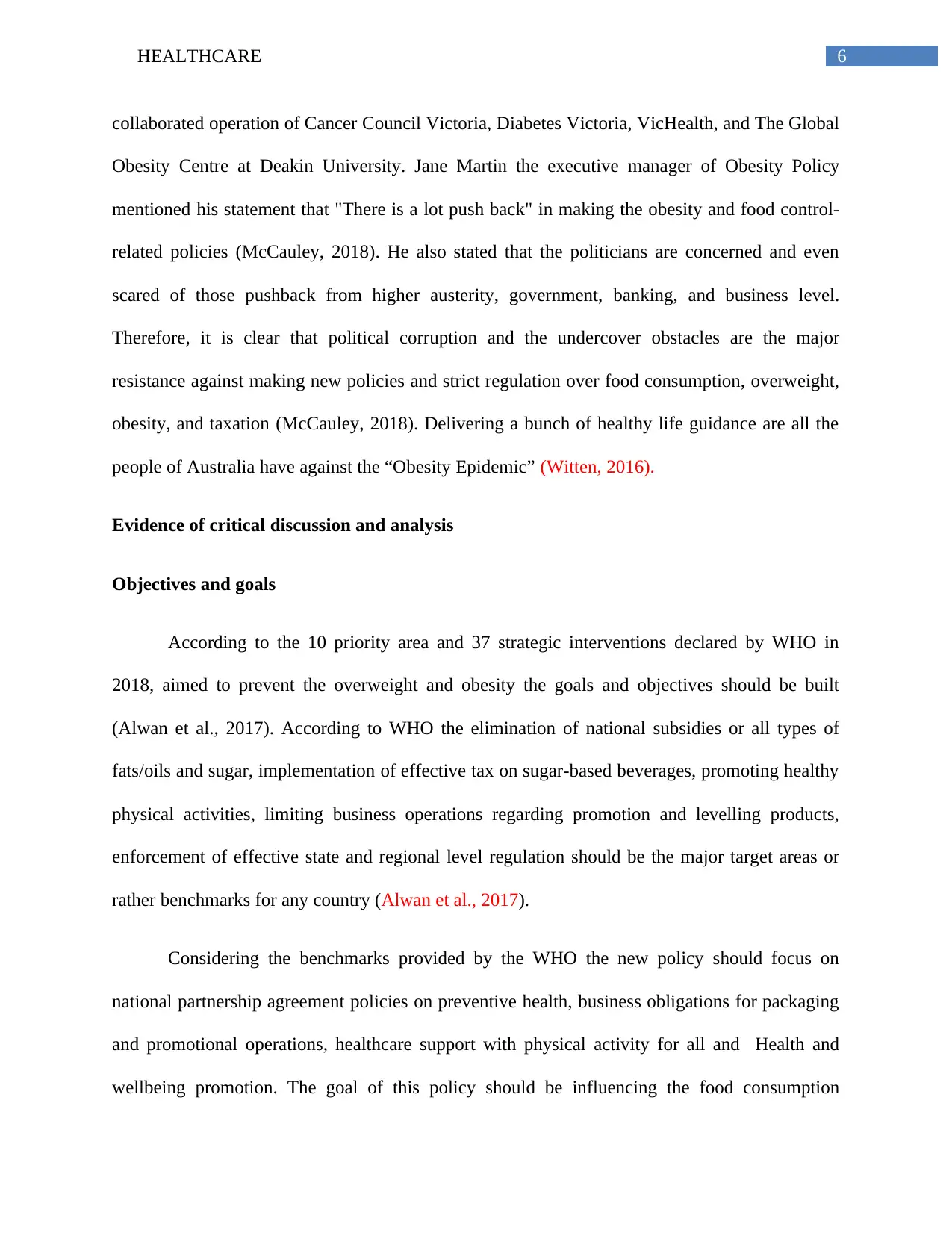
6HEALTHCARE
collaborated operation of Cancer Council Victoria, Diabetes Victoria, VicHealth, and The Global
Obesity Centre at Deakin University. Jane Martin the executive manager of Obesity Policy
mentioned his statement that "There is a lot push back" in making the obesity and food control-
related policies (McCauley, 2018). He also stated that the politicians are concerned and even
scared of those pushback from higher austerity, government, banking, and business level.
Therefore, it is clear that political corruption and the undercover obstacles are the major
resistance against making new policies and strict regulation over food consumption, overweight,
obesity, and taxation (McCauley, 2018). Delivering a bunch of healthy life guidance are all the
people of Australia have against the “Obesity Epidemic” (Witten, 2016).
Evidence of critical discussion and analysis
Objectives and goals
According to the 10 priority area and 37 strategic interventions declared by WHO in
2018, aimed to prevent the overweight and obesity the goals and objectives should be built
(Alwan et al., 2017). According to WHO the elimination of national subsidies or all types of
fats/oils and sugar, implementation of effective tax on sugar-based beverages, promoting healthy
physical activities, limiting business operations regarding promotion and levelling products,
enforcement of effective state and regional level regulation should be the major target areas or
rather benchmarks for any country (Alwan et al., 2017).
Considering the benchmarks provided by the WHO the new policy should focus on
national partnership agreement policies on preventive health, business obligations for packaging
and promotional operations, healthcare support with physical activity for all and Health and
wellbeing promotion. The goal of this policy should be influencing the food consumption
collaborated operation of Cancer Council Victoria, Diabetes Victoria, VicHealth, and The Global
Obesity Centre at Deakin University. Jane Martin the executive manager of Obesity Policy
mentioned his statement that "There is a lot push back" in making the obesity and food control-
related policies (McCauley, 2018). He also stated that the politicians are concerned and even
scared of those pushback from higher austerity, government, banking, and business level.
Therefore, it is clear that political corruption and the undercover obstacles are the major
resistance against making new policies and strict regulation over food consumption, overweight,
obesity, and taxation (McCauley, 2018). Delivering a bunch of healthy life guidance are all the
people of Australia have against the “Obesity Epidemic” (Witten, 2016).
Evidence of critical discussion and analysis
Objectives and goals
According to the 10 priority area and 37 strategic interventions declared by WHO in
2018, aimed to prevent the overweight and obesity the goals and objectives should be built
(Alwan et al., 2017). According to WHO the elimination of national subsidies or all types of
fats/oils and sugar, implementation of effective tax on sugar-based beverages, promoting healthy
physical activities, limiting business operations regarding promotion and levelling products,
enforcement of effective state and regional level regulation should be the major target areas or
rather benchmarks for any country (Alwan et al., 2017).
Considering the benchmarks provided by the WHO the new policy should focus on
national partnership agreement policies on preventive health, business obligations for packaging
and promotional operations, healthcare support with physical activity for all and Health and
wellbeing promotion. The goal of this policy should be influencing the food consumption
Paraphrase This Document
Need a fresh take? Get an instant paraphrase of this document with our AI Paraphraser
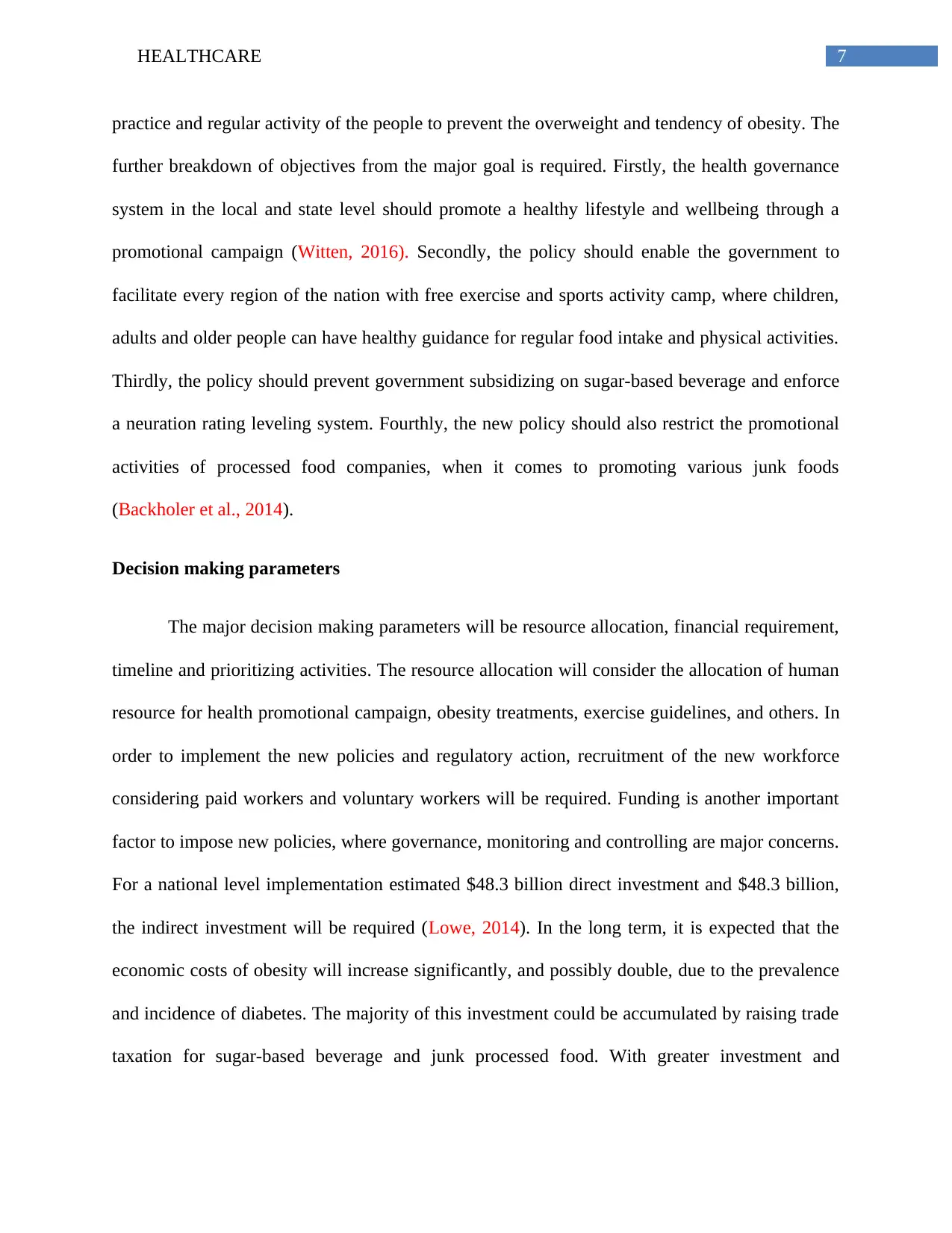
7HEALTHCARE
practice and regular activity of the people to prevent the overweight and tendency of obesity. The
further breakdown of objectives from the major goal is required. Firstly, the health governance
system in the local and state level should promote a healthy lifestyle and wellbeing through a
promotional campaign (Witten, 2016). Secondly, the policy should enable the government to
facilitate every region of the nation with free exercise and sports activity camp, where children,
adults and older people can have healthy guidance for regular food intake and physical activities.
Thirdly, the policy should prevent government subsidizing on sugar-based beverage and enforce
a neuration rating leveling system. Fourthly, the new policy should also restrict the promotional
activities of processed food companies, when it comes to promoting various junk foods
(Backholer et al., 2014).
Decision making parameters
The major decision making parameters will be resource allocation, financial requirement,
timeline and prioritizing activities. The resource allocation will consider the allocation of human
resource for health promotional campaign, obesity treatments, exercise guidelines, and others. In
order to implement the new policies and regulatory action, recruitment of the new workforce
considering paid workers and voluntary workers will be required. Funding is another important
factor to impose new policies, where governance, monitoring and controlling are major concerns.
For a national level implementation estimated $48.3 billion direct investment and $48.3 billion,
the indirect investment will be required (Lowe, 2014). In the long term, it is expected that the
economic costs of obesity will increase significantly, and possibly double, due to the prevalence
and incidence of diabetes. The majority of this investment could be accumulated by raising trade
taxation for sugar-based beverage and junk processed food. With greater investment and
practice and regular activity of the people to prevent the overweight and tendency of obesity. The
further breakdown of objectives from the major goal is required. Firstly, the health governance
system in the local and state level should promote a healthy lifestyle and wellbeing through a
promotional campaign (Witten, 2016). Secondly, the policy should enable the government to
facilitate every region of the nation with free exercise and sports activity camp, where children,
adults and older people can have healthy guidance for regular food intake and physical activities.
Thirdly, the policy should prevent government subsidizing on sugar-based beverage and enforce
a neuration rating leveling system. Fourthly, the new policy should also restrict the promotional
activities of processed food companies, when it comes to promoting various junk foods
(Backholer et al., 2014).
Decision making parameters
The major decision making parameters will be resource allocation, financial requirement,
timeline and prioritizing activities. The resource allocation will consider the allocation of human
resource for health promotional campaign, obesity treatments, exercise guidelines, and others. In
order to implement the new policies and regulatory action, recruitment of the new workforce
considering paid workers and voluntary workers will be required. Funding is another important
factor to impose new policies, where governance, monitoring and controlling are major concerns.
For a national level implementation estimated $48.3 billion direct investment and $48.3 billion,
the indirect investment will be required (Lowe, 2014). In the long term, it is expected that the
economic costs of obesity will increase significantly, and possibly double, due to the prevalence
and incidence of diabetes. The majority of this investment could be accumulated by raising trade
taxation for sugar-based beverage and junk processed food. With greater investment and
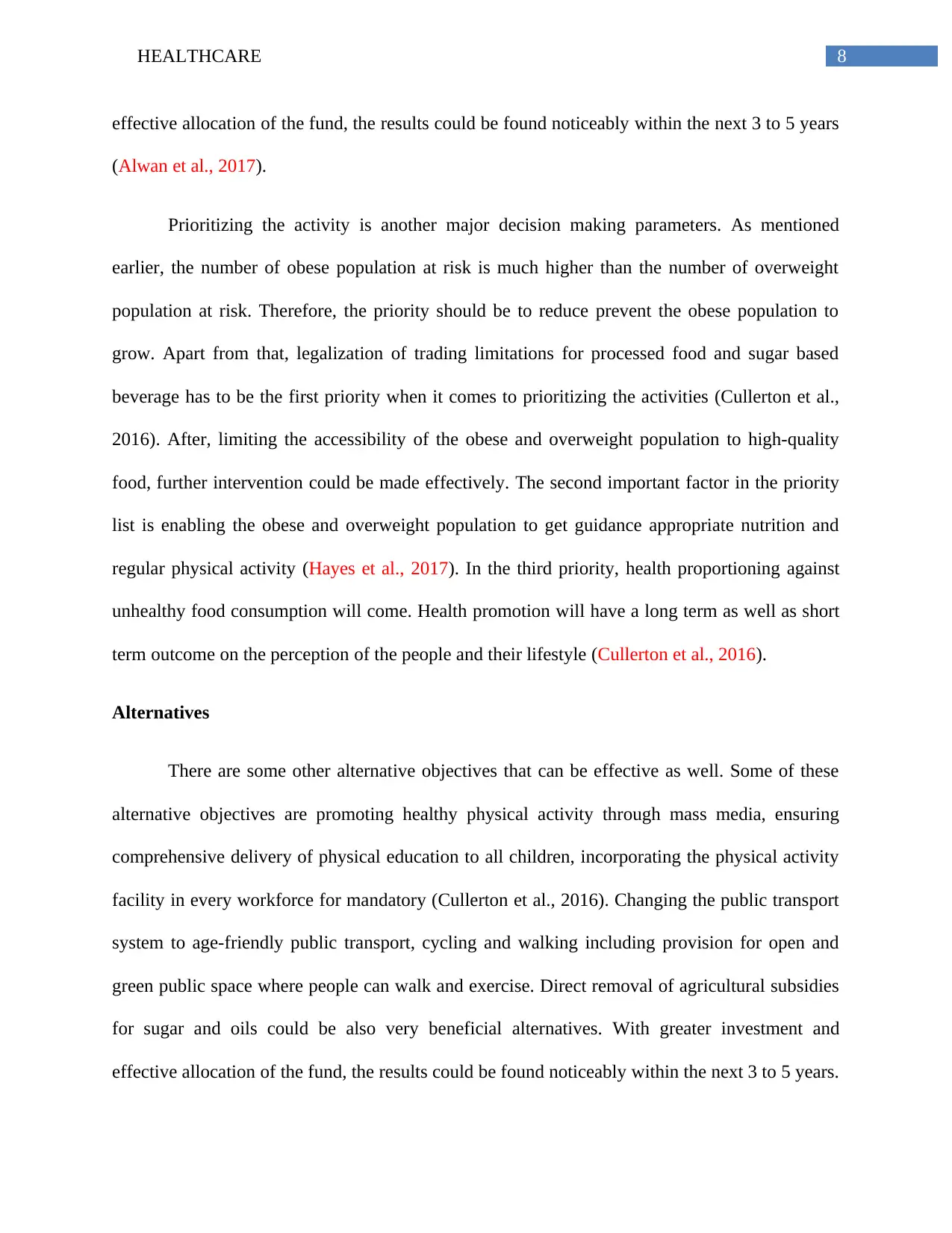
8HEALTHCARE
effective allocation of the fund, the results could be found noticeably within the next 3 to 5 years
(Alwan et al., 2017).
Prioritizing the activity is another major decision making parameters. As mentioned
earlier, the number of obese population at risk is much higher than the number of overweight
population at risk. Therefore, the priority should be to reduce prevent the obese population to
grow. Apart from that, legalization of trading limitations for processed food and sugar based
beverage has to be the first priority when it comes to prioritizing the activities (Cullerton et al.,
2016). After, limiting the accessibility of the obese and overweight population to high-quality
food, further intervention could be made effectively. The second important factor in the priority
list is enabling the obese and overweight population to get guidance appropriate nutrition and
regular physical activity (Hayes et al., 2017). In the third priority, health proportioning against
unhealthy food consumption will come. Health promotion will have a long term as well as short
term outcome on the perception of the people and their lifestyle (Cullerton et al., 2016).
Alternatives
There are some other alternative objectives that can be effective as well. Some of these
alternative objectives are promoting healthy physical activity through mass media, ensuring
comprehensive delivery of physical education to all children, incorporating the physical activity
facility in every workforce for mandatory (Cullerton et al., 2016). Changing the public transport
system to age-friendly public transport, cycling and walking including provision for open and
green public space where people can walk and exercise. Direct removal of agricultural subsidies
for sugar and oils could be also very beneficial alternatives. With greater investment and
effective allocation of the fund, the results could be found noticeably within the next 3 to 5 years.
effective allocation of the fund, the results could be found noticeably within the next 3 to 5 years
(Alwan et al., 2017).
Prioritizing the activity is another major decision making parameters. As mentioned
earlier, the number of obese population at risk is much higher than the number of overweight
population at risk. Therefore, the priority should be to reduce prevent the obese population to
grow. Apart from that, legalization of trading limitations for processed food and sugar based
beverage has to be the first priority when it comes to prioritizing the activities (Cullerton et al.,
2016). After, limiting the accessibility of the obese and overweight population to high-quality
food, further intervention could be made effectively. The second important factor in the priority
list is enabling the obese and overweight population to get guidance appropriate nutrition and
regular physical activity (Hayes et al., 2017). In the third priority, health proportioning against
unhealthy food consumption will come. Health promotion will have a long term as well as short
term outcome on the perception of the people and their lifestyle (Cullerton et al., 2016).
Alternatives
There are some other alternative objectives that can be effective as well. Some of these
alternative objectives are promoting healthy physical activity through mass media, ensuring
comprehensive delivery of physical education to all children, incorporating the physical activity
facility in every workforce for mandatory (Cullerton et al., 2016). Changing the public transport
system to age-friendly public transport, cycling and walking including provision for open and
green public space where people can walk and exercise. Direct removal of agricultural subsidies
for sugar and oils could be also very beneficial alternatives. With greater investment and
effective allocation of the fund, the results could be found noticeably within the next 3 to 5 years.
⊘ This is a preview!⊘
Do you want full access?
Subscribe today to unlock all pages.

Trusted by 1+ million students worldwide
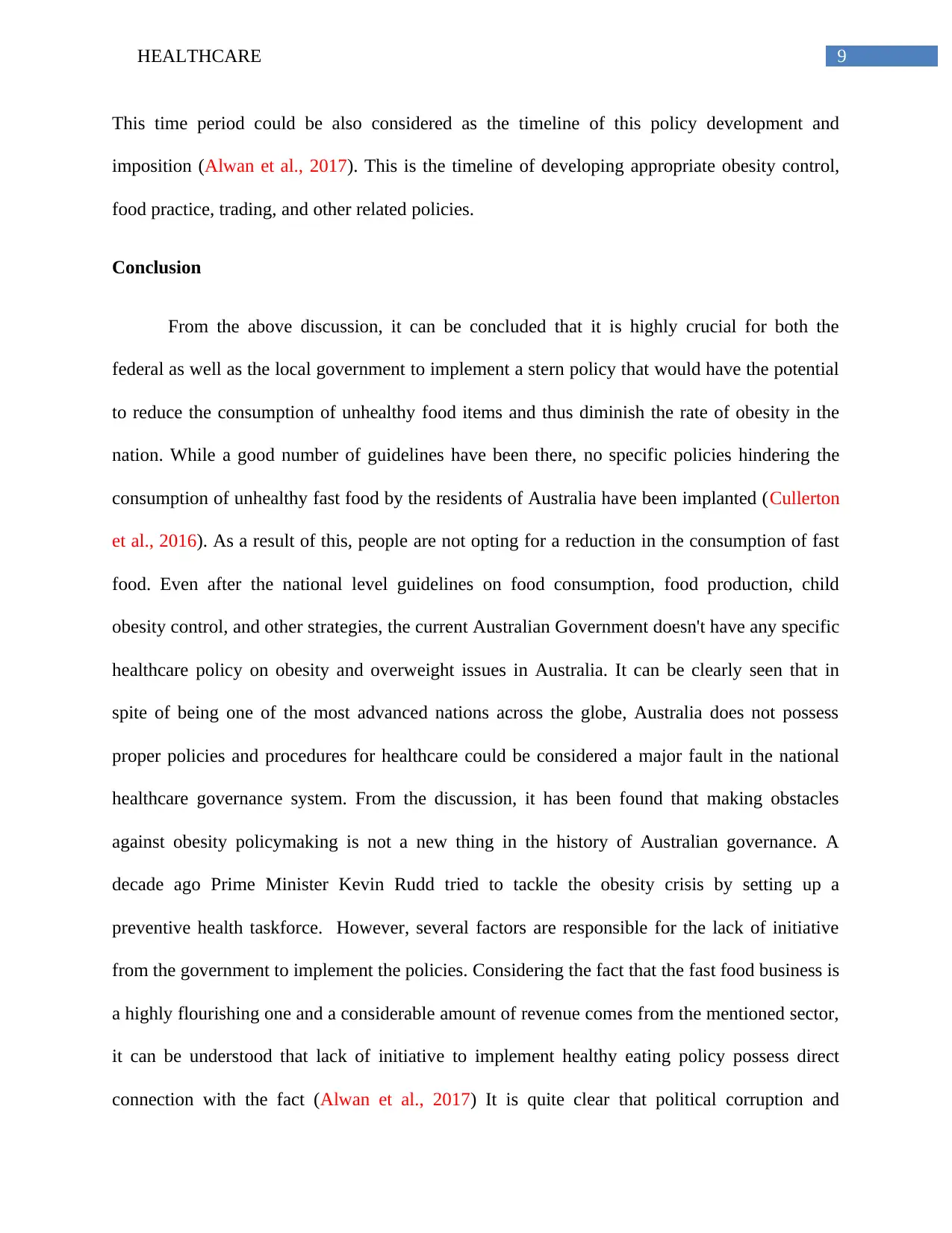
9HEALTHCARE
This time period could be also considered as the timeline of this policy development and
imposition (Alwan et al., 2017). This is the timeline of developing appropriate obesity control,
food practice, trading, and other related policies.
Conclusion
From the above discussion, it can be concluded that it is highly crucial for both the
federal as well as the local government to implement a stern policy that would have the potential
to reduce the consumption of unhealthy food items and thus diminish the rate of obesity in the
nation. While a good number of guidelines have been there, no specific policies hindering the
consumption of unhealthy fast food by the residents of Australia have been implanted (Cullerton
et al., 2016). As a result of this, people are not opting for a reduction in the consumption of fast
food. Even after the national level guidelines on food consumption, food production, child
obesity control, and other strategies, the current Australian Government doesn't have any specific
healthcare policy on obesity and overweight issues in Australia. It can be clearly seen that in
spite of being one of the most advanced nations across the globe, Australia does not possess
proper policies and procedures for healthcare could be considered a major fault in the national
healthcare governance system. From the discussion, it has been found that making obstacles
against obesity policymaking is not a new thing in the history of Australian governance. A
decade ago Prime Minister Kevin Rudd tried to tackle the obesity crisis by setting up a
preventive health taskforce. However, several factors are responsible for the lack of initiative
from the government to implement the policies. Considering the fact that the fast food business is
a highly flourishing one and a considerable amount of revenue comes from the mentioned sector,
it can be understood that lack of initiative to implement healthy eating policy possess direct
connection with the fact (Alwan et al., 2017) It is quite clear that political corruption and
This time period could be also considered as the timeline of this policy development and
imposition (Alwan et al., 2017). This is the timeline of developing appropriate obesity control,
food practice, trading, and other related policies.
Conclusion
From the above discussion, it can be concluded that it is highly crucial for both the
federal as well as the local government to implement a stern policy that would have the potential
to reduce the consumption of unhealthy food items and thus diminish the rate of obesity in the
nation. While a good number of guidelines have been there, no specific policies hindering the
consumption of unhealthy fast food by the residents of Australia have been implanted (Cullerton
et al., 2016). As a result of this, people are not opting for a reduction in the consumption of fast
food. Even after the national level guidelines on food consumption, food production, child
obesity control, and other strategies, the current Australian Government doesn't have any specific
healthcare policy on obesity and overweight issues in Australia. It can be clearly seen that in
spite of being one of the most advanced nations across the globe, Australia does not possess
proper policies and procedures for healthcare could be considered a major fault in the national
healthcare governance system. From the discussion, it has been found that making obstacles
against obesity policymaking is not a new thing in the history of Australian governance. A
decade ago Prime Minister Kevin Rudd tried to tackle the obesity crisis by setting up a
preventive health taskforce. However, several factors are responsible for the lack of initiative
from the government to implement the policies. Considering the fact that the fast food business is
a highly flourishing one and a considerable amount of revenue comes from the mentioned sector,
it can be understood that lack of initiative to implement healthy eating policy possess direct
connection with the fact (Alwan et al., 2017) It is quite clear that political corruption and
Paraphrase This Document
Need a fresh take? Get an instant paraphrase of this document with our AI Paraphraser
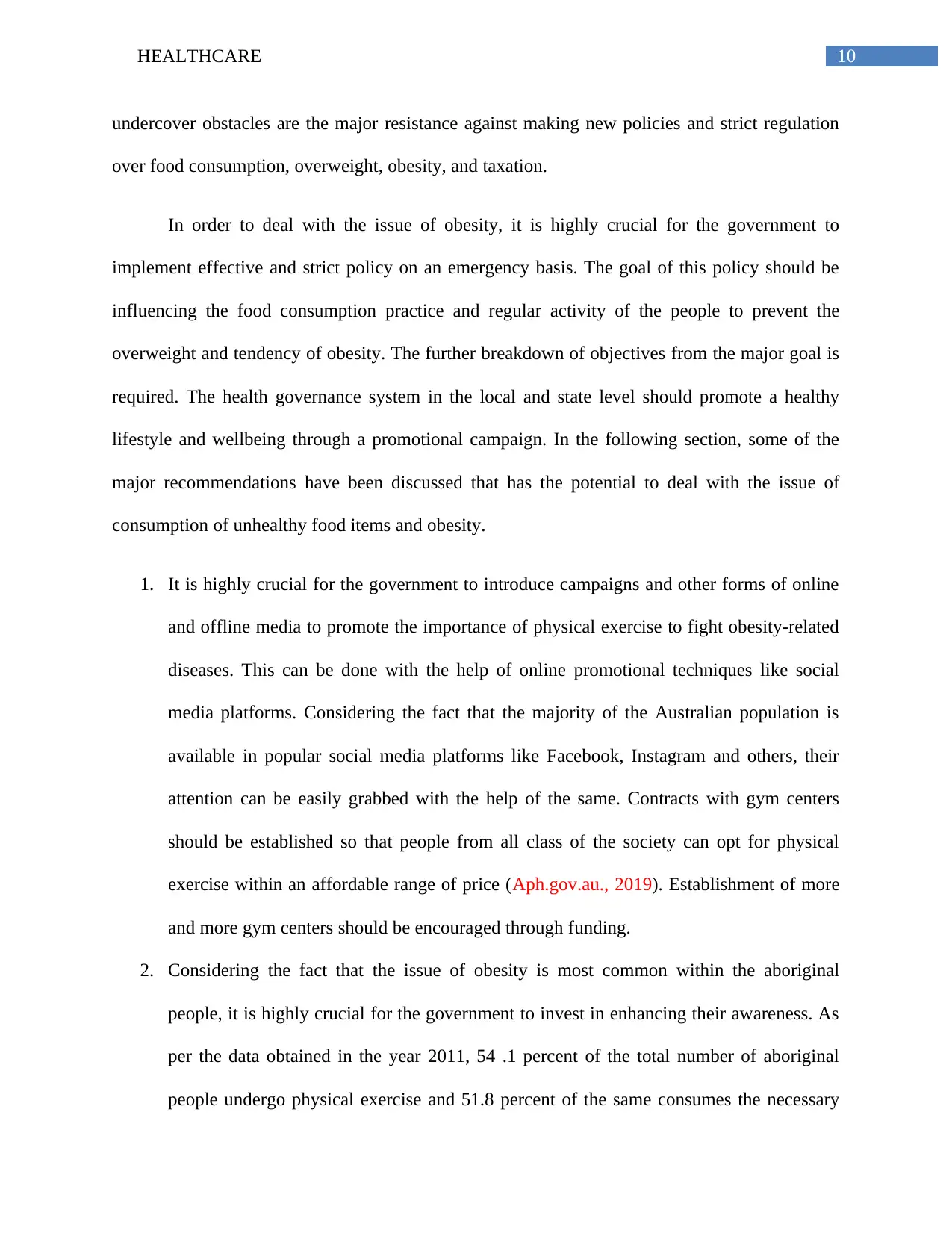
10HEALTHCARE
undercover obstacles are the major resistance against making new policies and strict regulation
over food consumption, overweight, obesity, and taxation.
In order to deal with the issue of obesity, it is highly crucial for the government to
implement effective and strict policy on an emergency basis. The goal of this policy should be
influencing the food consumption practice and regular activity of the people to prevent the
overweight and tendency of obesity. The further breakdown of objectives from the major goal is
required. The health governance system in the local and state level should promote a healthy
lifestyle and wellbeing through a promotional campaign. In the following section, some of the
major recommendations have been discussed that has the potential to deal with the issue of
consumption of unhealthy food items and obesity.
1. It is highly crucial for the government to introduce campaigns and other forms of online
and offline media to promote the importance of physical exercise to fight obesity-related
diseases. This can be done with the help of online promotional techniques like social
media platforms. Considering the fact that the majority of the Australian population is
available in popular social media platforms like Facebook, Instagram and others, their
attention can be easily grabbed with the help of the same. Contracts with gym centers
should be established so that people from all class of the society can opt for physical
exercise within an affordable range of price (Aph.gov.au., 2019). Establishment of more
and more gym centers should be encouraged through funding.
2. Considering the fact that the issue of obesity is most common within the aboriginal
people, it is highly crucial for the government to invest in enhancing their awareness. As
per the data obtained in the year 2011, 54 .1 percent of the total number of aboriginal
people undergo physical exercise and 51.8 percent of the same consumes the necessary
undercover obstacles are the major resistance against making new policies and strict regulation
over food consumption, overweight, obesity, and taxation.
In order to deal with the issue of obesity, it is highly crucial for the government to
implement effective and strict policy on an emergency basis. The goal of this policy should be
influencing the food consumption practice and regular activity of the people to prevent the
overweight and tendency of obesity. The further breakdown of objectives from the major goal is
required. The health governance system in the local and state level should promote a healthy
lifestyle and wellbeing through a promotional campaign. In the following section, some of the
major recommendations have been discussed that has the potential to deal with the issue of
consumption of unhealthy food items and obesity.
1. It is highly crucial for the government to introduce campaigns and other forms of online
and offline media to promote the importance of physical exercise to fight obesity-related
diseases. This can be done with the help of online promotional techniques like social
media platforms. Considering the fact that the majority of the Australian population is
available in popular social media platforms like Facebook, Instagram and others, their
attention can be easily grabbed with the help of the same. Contracts with gym centers
should be established so that people from all class of the society can opt for physical
exercise within an affordable range of price (Aph.gov.au., 2019). Establishment of more
and more gym centers should be encouraged through funding.
2. Considering the fact that the issue of obesity is most common within the aboriginal
people, it is highly crucial for the government to invest in enhancing their awareness. As
per the data obtained in the year 2011, 54 .1 percent of the total number of aboriginal
people undergo physical exercise and 51.8 percent of the same consumes the necessary
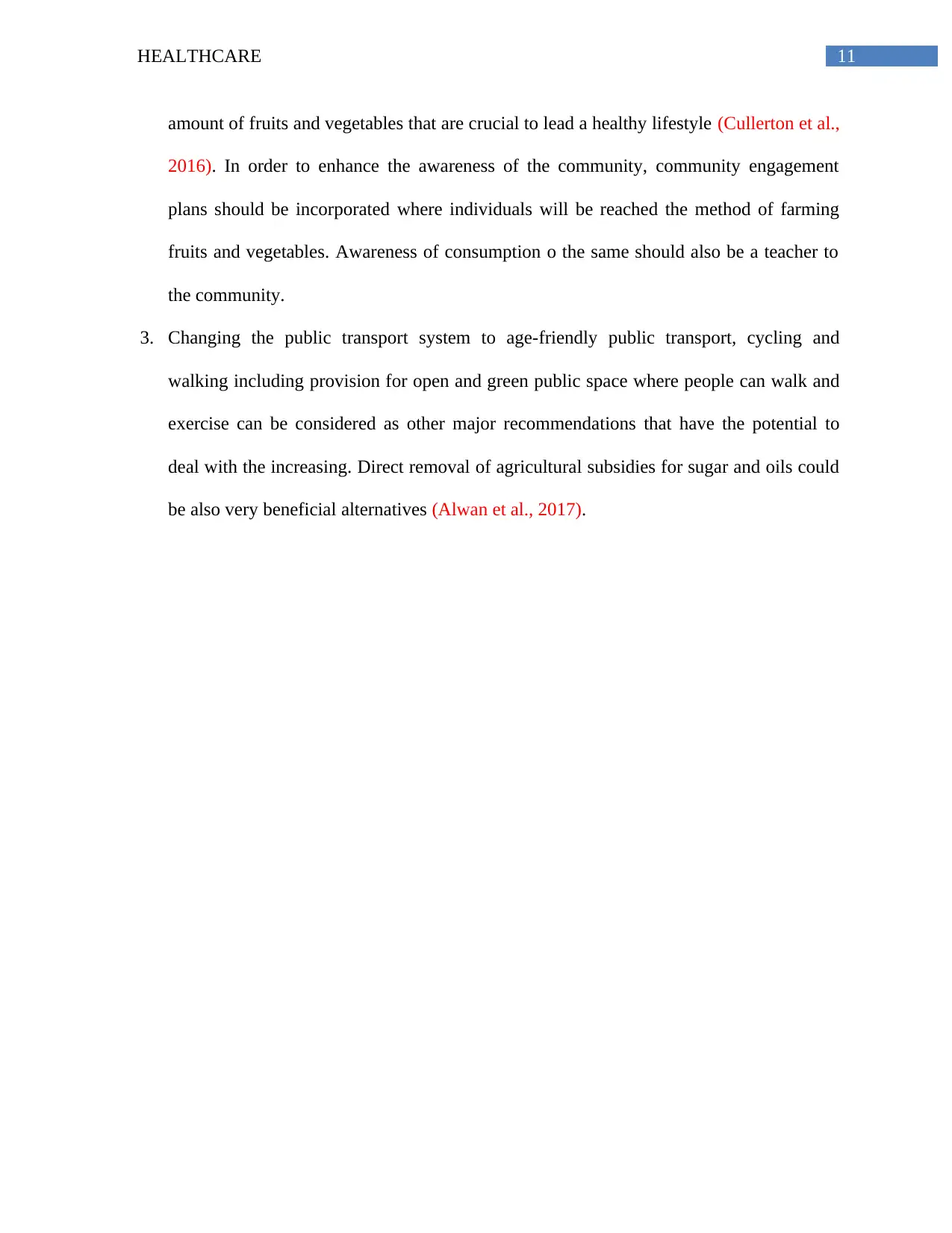
11HEALTHCARE
amount of fruits and vegetables that are crucial to lead a healthy lifestyle (Cullerton et al.,
2016). In order to enhance the awareness of the community, community engagement
plans should be incorporated where individuals will be reached the method of farming
fruits and vegetables. Awareness of consumption o the same should also be a teacher to
the community.
3. Changing the public transport system to age-friendly public transport, cycling and
walking including provision for open and green public space where people can walk and
exercise can be considered as other major recommendations that have the potential to
deal with the increasing. Direct removal of agricultural subsidies for sugar and oils could
be also very beneficial alternatives (Alwan et al., 2017).
amount of fruits and vegetables that are crucial to lead a healthy lifestyle (Cullerton et al.,
2016). In order to enhance the awareness of the community, community engagement
plans should be incorporated where individuals will be reached the method of farming
fruits and vegetables. Awareness of consumption o the same should also be a teacher to
the community.
3. Changing the public transport system to age-friendly public transport, cycling and
walking including provision for open and green public space where people can walk and
exercise can be considered as other major recommendations that have the potential to
deal with the increasing. Direct removal of agricultural subsidies for sugar and oils could
be also very beneficial alternatives (Alwan et al., 2017).
⊘ This is a preview!⊘
Do you want full access?
Subscribe today to unlock all pages.

Trusted by 1+ million students worldwide
1 out of 14
Related Documents
Your All-in-One AI-Powered Toolkit for Academic Success.
+13062052269
info@desklib.com
Available 24*7 on WhatsApp / Email
![[object Object]](/_next/static/media/star-bottom.7253800d.svg)
Unlock your academic potential
Copyright © 2020–2025 A2Z Services. All Rights Reserved. Developed and managed by ZUCOL.




